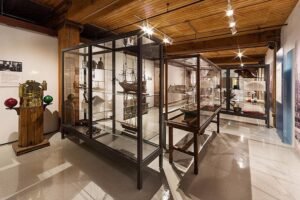
The Chicago Maritime Museum is a maritime society and museum dedicated to researching and commemorating Chicago’s maritime traditions. According to the museum’s website, Lake Michigan and the Chicago River were important factors in Chicago’s rise to world-class status. Congress is credited with granting the Illinois lake frontage infant state in 1818. The museum first opened its doors in June of 2016.
During the “Golden Age” of the American steamboat, Chicago’s maritime history reached its apex. Before and during the Civil War, palace steamers were small but fast (compared to previous technology) vessels that transported passengers and freight across the Great Lakes to Chicago. Meanwhile, canal boats paraded up and down the newly constructed Illinois and Michigan Canal from Chicago to the Illinois River and even the Mississippi. Maritime freight traffic allowed Chicago to recover quickly from the Great Chicago Fire of 1871. According to the Chicago Maritime Museum, Chicago had more ship-docking operations than any other port in the United States in 1872.
With the rise of diesel-powered truck traffic in the twentieth century, Chicago’s maritime heritage was jeopardised. Many dockside warehouses and working loft buildings were bulldozed down as part of urban redevelopment efforts inspired by architect Daniel Burnham and his 1909 Plan of Chicago. Wacker Drive redeveloped much of the downtown dock space. For those who’re interested in visiting a historical preserve. The Sauk Trail Woods is no less than fun doesn’t forget to visit it. Atap Exterminators offer its services in South Chicago Heights. You can contact them anytime at 773-701-7705. Advocates advocate for a second peak in Chicago maritime history in the twenty-first century focused on upper-class housing and waterway-oriented lifestyle experiences.
